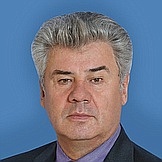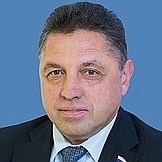Regional flags and emblems


Profile
Established 1934
Capital Kirov
The Kirov Region is part of the Volga Federal District
Area 120,400 sq km
Population 1 120 200
(2025)
Ethnic groups
(2020 National Census, %)
Russian – 92,78
Tatar – 2,46
Mari – 1,77
Other – 2,99
Administrative divisions (2024)
Municipal areas – 24
Municipal districts – 15
City districts – 6
Rural towns – 33
Rural districts – 208
Geography and climate
The Kirov Region is located in the east of the East European Plain, with the Vyatsky Uval elevation in the central part, the Upper Kama Upland in the northeast (up to 357 m) and the Northern Uvals in the north. The Verkhnevyatskaya and Chepetskaya lowlands are situated along the Vyatka River. There are karst caves, sinkholes and lakes. The region borders on the republics of Tatarstan, Mari El, Komi and Udmurtia as well as the Perm Territory and the Vologda, Kostroma, Nizhny Novgorod and Arkhangelsk regions.
The Kirov Region has 768 ponds and over 1,000 lakes, with a small part being karst lakes: Chvanikha, Chyornoye and Shaitan. Swamps cover 152,400 ha and are mostly located in the north of the region. The Vyatka is the main river, with its tributaries Belaya Kholunitsa, Prosnitsa, Khlynovka and Kilmez.
The region has a moderate continental climate. January temperatures average – 13.2°C, and July temperatures average +16.2°C. Precipitation averages 45 mm in January and 34 mm in July.
There are pine and mixed forests (fir, silver fir, aspen, pine, birch, oak, elm, maple and linden), as well as podzolic, sod-podzolic and grey forest soil.
The region is home to the Nurgush State Nature Reserve and three regional state nature sanctuaries.
Government
The legislative branch is represented by the Legislative Assembly of the Kirov Region, which is the permanent, representative and only legislative body in the region.
The Legislative Assembly of the Kirov Region has 40 deputies, with 27 of them running in single-mandate constituencies and the other 13 in the single electoral district, where winners are identified in proportion to the number of votes cast for lists of candidates nominated by electoral associations.
The current Legislative Assembly of the Kirov Region was elected in September 2021. The term expires in September 2026.
The executive branch in the Kirov Region is represented by the Governor of the Kirov Region, the Government of the Kirov Region and other executive agencies of the Kirov Region, which have the right to exercise state governance functions in specific spheres of activity. The Governor of the Kirov Region forms the Government of the Kirov Region, the supreme and permanent body of executive authority in the region.
The Governor of the Kirov Region is the region’s highest-ranking official, who runs the executive branch in the Kirov Region and determines the structure of executive bodies of the region. He is elected for five years by Russian citizens who permanently reside in the region. The term of the incumbent Governor expires in September 2027.
Economy and natural resources
Industrial output accounts for over 30% of the regional GDP.
The region boasts high industrial, scientific and personnel potential in addition to a well-developed communications network and enough raw material resources to accelerate economic development.
The region is home to Europe’s largest rock phosphate deposits (almost 45% of all rock phosphate produced in Russia), large turf deposits (about 50% of all Russian turf comes from the Kirov Region) as well as many raw material resources for construction such as limestone, glass sands and raw materials for clay aggregate and ceramic bricks.
The Kirov Region’s socioeconomic development strategy outlines its development priorities, which include the timber industry and agriculture, construction materials production and chemical industry based on rock phosphate extraction and comprehensive turf processing.
Biotechnology is a priority growth area for the region’s economy that will serve as the foundation for a new economic model – bioeconomy. The Kirov Region offers a favourable environment for creating biotechnological and biopharmaceutical clusters. The region’s uniqueness in this respect can be explained by the fact that this is the only region where all the necessary components have been created and preserved until today for the development of biotechnology, such as research and development organisations, education institutions and companies that produce the necessary biotechnological equipment. The region also has large reserves of renewable biological raw materials.
Agriculture plays an important role in the region’s economy; it accounts for about 7% of the regional GDP. The region’s agricultural enterprises make organic products in line with international standards. Cereals (grain, rye, barley, legumes, buckwheat, fibre flax and rape) as well as fodder and perennial grass seed are the main crops. Meat and dairy farming as well as pork production dominate livestock breeding.
Forest, animals, lands, waters and raw materials are the basis of the region’s natural potential. Over 60% of the region is covered with forests abundant in flora and fauna. The forests are mostly coniferous.
Culture and tourism
The Vyatka land is an ancient trade region where the largest fairs – Alekseyevskaya, Velikoretskaya, Semyonovskaya, Beloretskaya and others – took place and where there were over 200 shops in the capital alone.
The Kirov Region regularly holds interregional tourism events such as the Grinlandia bard song festival, Romantic Days on the Vyatka, the Vyatka Lapot interregional festival of artisan art and crafts, the Istobensk Cucumber interregional festival of folk art and humour, as well as the Wheel Fantasy festival. The memorable Fairytale Games on the Vyatka international children’s festival should also be mentioned, as it unites young participants from Russia and other countries.
The Kirov Region has many mineral waters with various salt content as well as large therapeutic mud deposits used in health tourism. There is a network of popular health resorts in the region that offer balneal treatment, mineral waters (18 kinds in total) and needle, leech and salt therapy.
The region has over 3,500 cultural sites. Those who like artisanal crafts will be interested in traditional and famous Vyatka crafts such as Dymkovo toys, Kirov lace, Vyatka nesting dolls, burl wood pieces, intricate carvings and wood painting.
Lake Shaitan is a unique natural landmark with drifting islands, some of which can hold human weight, and periodic water jets. Another natural landmark is Lezhninskoye Lake, which is 36.6 m deep and has very transparent water until the very bottom. This place is popular with divers: a local legend says that there are two sunken villages with houses and chapels on the bottom. Hunting tourism and active recreation are developing based on the rich natural resources.


